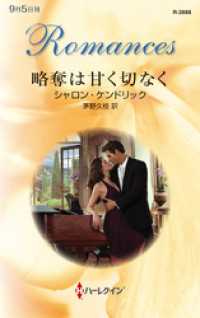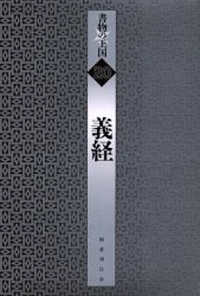- ホーム
- > 洋書
- > 英文書
- > Science / Mathematics
Full Description
Luminescence is just as fascinating and luminescent materials (are) just as important as the number of books on these topics are rare. We have met many beginners in these fields who have asked for a book introducing them to luminescence and its applications, without knowing the appropriate answer. Some very useful books are completely out of date, like the first ones from the late I 940s by Kroger, Leverenz and Pringsheim. Also those edited by Goldberg (1966) and Riehl (1971) can no longer be recommended as up-to-date introductions. In the last decade a few books of excellent quality have appeared, but none of these can be considered as being a general introduction. Actually, we realize that it is very difficult to produce such a text in view of the multidisciplinary character of the field. Solid state physics, molecular spectroscopy, ligand field theory, inorganic chemistry, solid state and materi"als chemistry all have to be blended in the correct proportion.
Contents
1 A General Introduction to Luminescent Materials.- 2 How Does a Luminescent Material Absorb Its Excitation Energy?.- 2.1 General Considerations.- 2.2 The Influence of the Host Lattice.- 2.3 The Energy Level Diagrams of Individual Ions.- 2.4 Host Lattice Absorption.- 3 Radiative Return to the Ground State: Emission.- 3.1 Introduction.- 3.2 General Discussion of Emission from a Luminescent Center.- 3.3 Some Special Classes of Luminescent Centers.- 3.4 Afterglow.- 3.5 Thermoluminescence.- 3.6. Stimulated emission.- 4 Nonradiative Transitions.- 4.1 Introduction.- 4.2 Nonradiative Transitions in an Isolated Luminescent Centre.- 4.3 Efficiency.- 4.4 Maximum Efficiency for High Energy Excitation [13].- 4.5 Photoionization and Electron-Transfer Quenching.- 4.6 Nonradiative Transitions in Semiconductors.- 5 Energy Transfer.- 5.1 Introduction.- 5.2 Energy Transfer Between Unlike Luminescent Centers.- 5.3 Energy Transfer Between Identical Luminescent Centers.- 5.4 Energy Transfer in Semiconductors.- 6 Lamp Phosphors.- 6.1 Introduction.- 6.2 Luminescent Lighting [1-3].- 6.3 The Preparation of Lamp Phosphors.- 6.4 Photoluminescent Materials.- 6.5 Outlook.- 7 Cathode-Ray Phosphors.- 7.1 Cathode-Ray Tubes: Principles and Display.- 7.2 Preparation of Cathode-Ray Phosphors.- 7.3 Cathode-Ray Phosphors.- 7.4 Outlook.- 8 X-Ray Phosphors and Scintillators (Integrating Techniques).- 8.1 Introduction.- 8.2 Preparation of X-ray Phosphors.- 8.3 Materials.- 8.4 Outlook.- 9 X-Ray Phosphors and Scintillators (Counting Techniques).- 9.1 Introduction.- 9.2 The Interaction of Ionizing Radiation with Condensed Matter.- 9.3 Applications of Scintillator Crystals.- 9.4 Material Preparation (Crystal Growth).- 9.5 Scintillator Materials.- 9.6 Outlook.- 10 Other Applications.- 10.1 Upconversion:Processes and Materials.- 10.2 The Luminescent Ion as a Probe.- 10.3 Luminescence Immuno-Assay.- 10.4 Electroluminescence.- 10.5 Amplifiers and Lasers with Optical Fibers.- 10.6 Luminescence of Very Small Particles.- Appendix 1. The Luminescence Literature.- Appendix 2. From Wavelength to Wavenumber and Some Other Conversions.- Appendix 3. Luminescence, Fluorescence, Phosphoresence.- Appendix 4. Plotting Emission Spectra.
-

- 電子書籍
- 略奪は甘く切なく ハーレクイン
-

- 電子書籍
- 黒鍵は恋してる 集英社文庫






